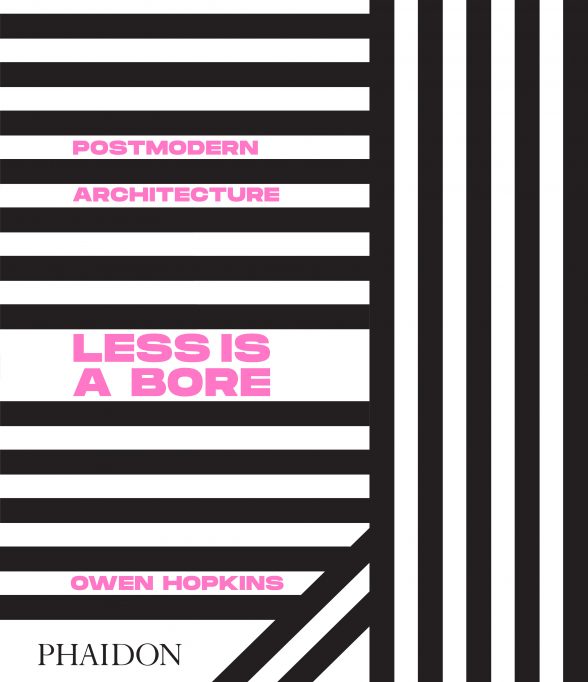This website uses cookies
This website uses cookies to enable it to function properly and to analyse how the website is used. Please click 'Close' to accept and continue using the website.


Postmodern Architecture: Less is a Bore
Owen Hopkins (published by Phaidon, £29.95)
Reviewed by Geraint Franklin
February 2020

How will post-modernism evolve after Charles Jencks? I recall standing, strangely enough, in a phone-box off Fitzroy Square, feeding in a stream of coins in return for advice, proffered half-cajolingly and half-proprietorially, on Post-Modern Buildings in Britain. Jencks rejected the idea of post-modernism as a stylistic label with a start date and an end date. He seemed ambivalent towards the reprise of post-modernism as a collection of design objects (Judith Gura’s Postmodern Design Complete, 2017) or buildings (Adam Nathaniel Furman and Terry Farrell’s Revisiting Postmodernism, 2017). Post-modernism was infinitely bigger than that; a world view based on cultural pluralism and complexity science.
Yet I’m sure Jencks would have much to enjoy (and argue with) in this book, Postmodern Architecture Less is a Bore a follow-up to The Return of the Past: Postmodernism in British Architecture, Owen Hopkins’s 2018 exhibition at the Soane Museum where he is senior curator. As a predominantly visual survey, lavish and international in scope, it could be considered the post-modern answer to This Brutal World, also published by Phaidon. Both books showcase photogenic movements in architecture whose rediscovery has been powered by Twitter, Instagram and Dezeen.
Unlike the Soane show, whose focus was the early ‘radical moment’ of British post-modernism, Less is a Bore is an inclusive affair with an international cast list which ranges from 1960s antecedents (Philip Johnson, Minoru Yamasaki) to present day practitioners (Can, Studio Mutt, Monadnock). This makes for a catholic yet comprehensive compilation – a sort of architectural equivalent to a Now That’s What I Call Music! album, but with better graphics.
This is not the sort of book to agonise over definitions or boundaries – one could quibble with the inclusion of Broadgate Circle and Portcullis House – but the selection of over 200 examples gels through sheer exuberance and eclecticism. Interleaved with the photos are a series of thoughts on post-modern architecture and culture from the writings of such figures as Jane Jacobs, Andy Warhol and David Byrne.
While the greatest hits are present and correct, including a good showing of British Po-Mo, a fair few discoveries lie in wait. Alessandro Mendini’s Steintor tram and bus stop in Hannover and O M Unger’s heroic pumping station in Berlin’s Tiergarten were new to me, as was the vaguely dystopian architecture of Japan’s Shin Takamatsu. South America is represented by the Neo-Andean architecture of Freddy Mamani Silvestre in El Alto, Bolivia (although Brazil’s Ruy Ohtake is sadly absent). I’d forgotten about Stirling and Wilford’s Temasek Polytechnic in Singapore, a posthumous reprise of white modernism. And I confess to enjoying Léon Krier’s Perez Architecture Center and Windsor Village Hall in Florida, so much more convincing than his grouchy New Urbanist polemicising.
A thoughtful, zeitgeisty introduction ponders post-modernism as a cultural response to the political and economic shifts of the 1970s – and what its re-emergence after 2008 might signify. Hopkins suggests that the relevance of post-modernism for the present moment lies in its acceptance of disorder, complexity and contingency and its recognition of the marginal, overlooked or oppressed. ‘Post-modernism is not an argument for relativism but for the very value of pluralism, permissiveness and un-thought of possibility,’ he argues.
A useful counterpart to the Phaidon book is The Return of the Past: Conversations on Postmodernism, published by the Soane to accompany the 2018 show, and still easy enough to obtain online. It features insightful interviews with Jeremy Dixon, Edward Jones, Terry Farrell, Piers Gough and Rex Wilkinson of CZWG, John Outram, Charles Jencks, Laurence Bain and Michael Wilford. There’s a pleasing continuity to the fact that Jencks curated the first exhibition of British post-modern architecture which drew together Dixon, Jones, Farrell, Gough, Outram and James Gowan. ‘One has to explain,’ Peter Cook wrote, ‘that the brouhaha that surrounded the arrival of “Postmodernism in England” in the name of six shy men could only have been stage-managed by an American.’
We are still populating our book review section. You will be able to search by book name, author or date of publication.

Become a C20 member today and help save our modern design heritage.